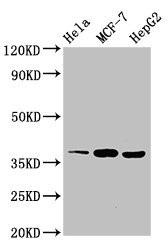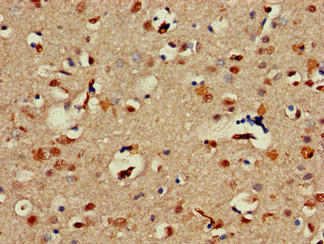Description
| Antibody Name: | ALX1 Antibody (PACO52406) |
| Antibody SKU: | PACO52406 |
| Size: | 50ug |
| Host Species: | Rabbit |
| Tested Applications: | ELISA, WB, IHC |
| Recommended Dilutions: | ELISA:1:2000-1:10000, WB:1:500-1:5000, IHC:1:20-1:200 |
| Species Reactivity: | Human |
| Immunogen: | Recombinant Human ALX homeobox protein 1 protein (10-304AA) |
| Form: | Liquid |
| Storage Buffer: | Preservative: 0.03% Proclin 300 Constituents: 50% Glycerol, 0.01M PBS, pH 7.4 |
| Purification Method: | >95%, Protein G purified |
| Clonality: | Polyclonal |
| Isotype: | IgG |
| Conjugate: | Non-conjugated |
 | Western Blot. Positive WB detected in: Hela whole cell lysate, MCF-7 whole cell lysate, HepG2 whole cell lysate. All lanes: ALX1 antibody at 3µg/ml. Secondary. Goat polyclonal to rabbit IgG at 1/50000 dilution. Predicted band size: 37 kDa. Observed band size: 37 kDa. |
 | Immunohistochemistry of paraffin-embedded human brain tissue using PACO52406 at dilution of 1:100. |
| Background: | Sequence-specific DNA-binding transcription factor that binds palindromic sequences within promoters and may activate or repress the transcription of a subset of genes. Most probably regulates the expression of genes involved in the development of mesenchyme-derived craniofacial structures. Early on in development, it plays a role in forebrain mesenchyme survival. May also induce epithelial to mesenchymal transition (EMT) through the expression of SNAI1. |
| Synonyms: | ALX homeobox protein 1 (Cartilage homeoprotein 1) (CART-1), ALX1, CART1 |
| UniProt Protein Function: | Cart1: Transcriptional activator that acts at a palindromic recognition sequence to enhance the activity of the SV40 and TK promoters. Functions as a repressor with the prolactin promoter in vivo. May play a role in chondrocyte differentiation and may also influence cervix development. Defects in ALX1 are the cause of frontonasal dysplasia type 3 (FND3). The term frontonasal dysplasia describes an array of abnormalities affecting the eyes, forehead and nose and linked to midfacial dysraphia. The clinical picture is highly variable. Major findings include true ocular hypertelorism; broadening of the nasal root; median facial cleft affecting the nose and/or upper lip and palate; unilateral or bilateral clefting of the alae nasi; lack of formation of the nasal tip; anterior cranium bifidum occultum; a V-shaped or widow's peak frontal hairline. Belongs to the paired homeobox family.Protein type: DNA-bindingChromosomal Location of Human Ortholog: 12q21.31Cellular Component: Golgi apparatus; nucleoplasm; nucleusMolecular Function: protein binding; transcription corepressor activity; transcription factor activityBiological Process: cartilage condensation; multicellular organismal development; negative regulation of transcription from RNA polymerase II promoter; positive regulation of transcription from RNA polymerase II promoter; positive regulation of transcription, DNA-dependent; transcription from RNA polymerase II promoterDisease: Frontonasal Dysplasia 3 |
| UniProt Protein Details: | |
| NCBI Summary: | The specific function of this gene has yet to be determined in humans; however, in rodents, it is necessary for survival of the forebrain mesenchyme and may also be involved in development of the cervix. Mutations in the mouse gene lead to neural tube defects such as acrania and meroanencephaly. [provided by RefSeq, Jul 2008] |
| UniProt Code: | Q15699 |
| NCBI GenInfo Identifier: | 90111820 |
| NCBI Gene ID: | 8092 |
| NCBI Accession: | Q15699.2 |
| UniProt Secondary Accession: | Q15699,Q546C8, Q96FH4 |
| UniProt Related Accession: | Q15699 |
| Molecular Weight: | 36,961 Da |
| NCBI Full Name: | ALX homeobox protein 1 |
| NCBI Synonym Full Names: | ALX homeobox 1 |
| NCBI Official Symbol: | ALX1 |
| NCBI Official Synonym Symbols: | FND3; CART1; HEL23 |
| NCBI Protein Information: | ALX homeobox protein 1 |
| UniProt Protein Name: | ALX homeobox protein 1 |
| UniProt Synonym Protein Names: | Cartilage homeoprotein 1 |
| Protein Family: | ALX homeobox protein |
| UniProt Gene Name: | ALX1 |
| UniProt Entry Name: | ALX1_HUMAN |






